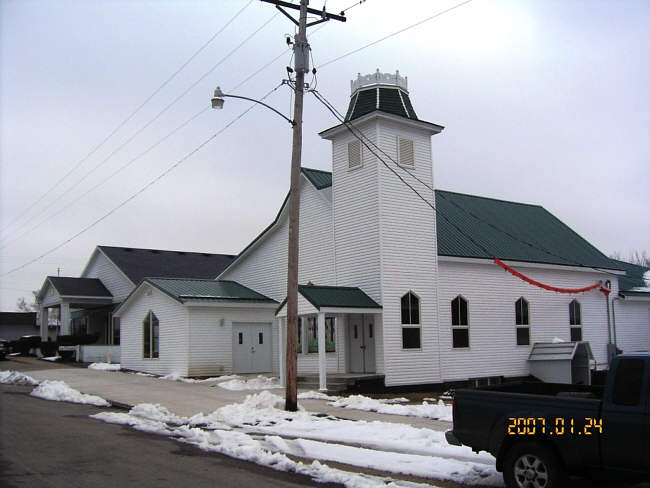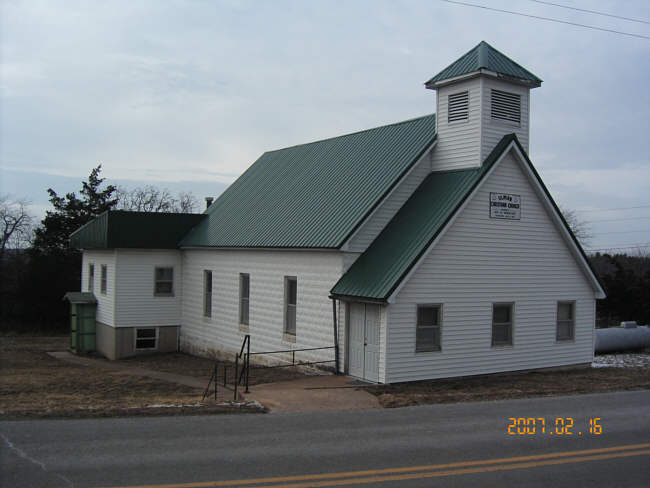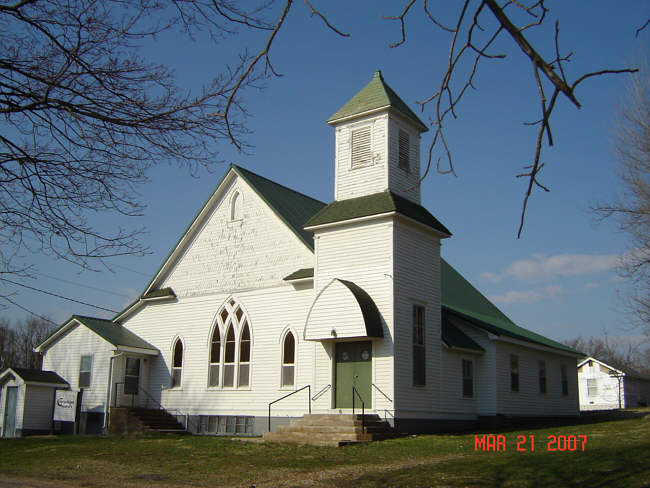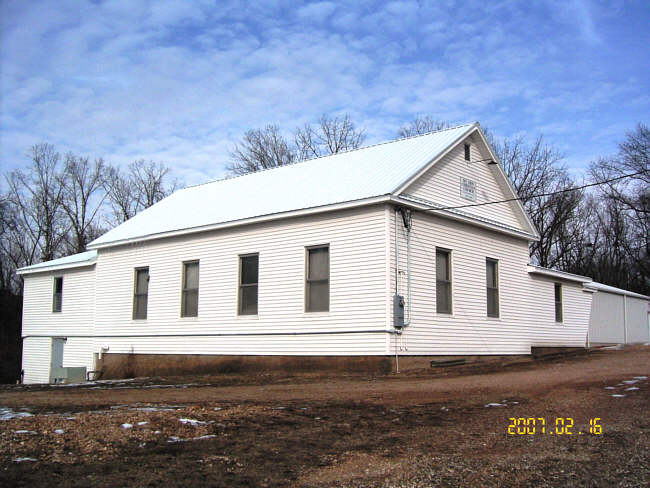|

Churches of Miller County
THE CHRISTIAN CHURCH
The Disciples of Christ
The first church of the Christian denomination known as the Disciples of Christ was organized near Pleasant Mount in 1850; the second near Spring Garden. There followed a number of other congregations until 1890 there were 15 organizations with a membership of 1000. Probably the first minister was Dr. J.C. Glass, a physician who lived near Brumley, Missouri. There followed Nelson Davis, T.S. Phillips, W.P. Dorsey, J.D. Thompson of Iberia, Owen Workman, J.S. Bonham, E. Wilkes, D.W. Conner, and H.D. Rutter. The church at Brumley was formed in 1883 under the direction of D.W. Conner. J.C. Thompson was its regular pastor for 25 years.
A building for the Christian Church at Tuscumbia was completed and dedicated in August, 1889. For a while Tuscumbia had been the only county seat in the state without a church building, her only church house having been disrupted before the Civil War. For the two intervening decades services had been held in the courthouse and other buildings. Reverend S.A. Crouch is the present Christian minister at Tuscumbia, and Reverend R.T. Moneymaker is pastor of the Brumley church. The Old Salem Church was dissolved into three divisions in 1882: Mt. Pleasant, Olean and Eldon.
Two years later the Eldon congregation was reorganized. Their first church building was dedicated in 1891 by G.A. Hoffman of St. Louis. In 1893 Reverend Edmund Wilkes was chosen pastor. As the church membership grew a larger building was erected of brick and was dedicated in December, 1893, by Reverends Wilkes and Garrison. The ministers of the church since then have been B.F. Hill, C.C. Hill, J.S. Vance, J.T. Bickel, H.J. Corwine, S.D. Dutcher, T.B. Ray, W.L. Ruce, Emmett Davison, J.K. O'Heeron, J.W. Baily, W.P. Bell, C.R. Piety, and A.L. Alexander. The membership today is nearly five hundred.
-A History of Miller County, Missouri
By Gerard Schultz, 1933
BRAYS ADVENT CHRISTIAN CHURCH
Heritage Sunday: October 21, 1979
The 1870's marked a particular beginning fro Bray's Union Church. Although the exact first meeting of neighbors for Christian fellowship is not available, it surely pre-dated the 1870's. By the late 1870's fellowship meetings were held in neighbor's homes, and were regular enough to warrant consideration for a permanent building. In 1877 James Morrow sold to his nephew, William Wiley Morrow, eighty acres of land. Within this tract the future Bray's Union Church would be built.
In 1885 Will Morrow sold seventy-nine acres of the above eighty to George "Mart" Humphrey, keeping one acre aside for a church site. In January 1887, the Christian Advent, Baptist, Christian, and Church of God adherents bought the one acre from Will and Atha Ann Morrow for five dollars. The Baptist and Christian denominations had been successful pre-Civil War groups in Richwoods. The Christian Advent and Church of God faiths came after the War. The land was conveyed "for church purposes and for public burying ground for all persons."
Billie Humphrey, Mart Humphrey, Will Morrow, Henry Tyler, and others constructed the church building. Harrison Smith was foreman for construction of the limestone steps leading intot he front door. The stone was probably quarried at the stone quarry below the junction of Bolin and Tavern creeks. The burning of a neighborhood school east of the church required the 1893 school year to be held in Union Church. After the school term in Union Church, a new Bray's school opened offering "lickin' and larnin'".
Preaching at Bray's Union Church was irregular for many years. Hannah Humphrey, Nellie Newhart, and Atha Ann Morrow encouraged a regular Sunday school, and George Shepherd taught a singing class. Religious experience in the Bray's neighborhood has changed with the passing of time. In the summer, brush arbors had been held at the St. Anthony "Y" and at Bray's spring; Baptists washed feet at the door of Union Church; fall tent revivals were held east of the Union Church building; until the early twentieth century, baptisms were performed in the now gravel-choked Bolin's creek just south of the church building. In later years the Big Tavern Creek was the scene of multiple baptisms and the swimming pool behind Bray's mill also served as baptistery.
The obituary for Hannah Humphrey was written by one of Union's early ministers, George DeBeer. Hannah was a charter member of the Advent Christian Church at Bray's "some thirty-five years" before her death in July 1913. Homes like the Humphrey's were the settings for neighborhood fellowship in the late 1870's and early 1880's. The Mart and Hannah Humphrey family was representative of the proverbial large family with numerous descendants. When Mart passed away in March, 1939, he left thirteen children, seventy-two grandchildren, and seventy great-grandchildren.
Union churches have been a historic phenomenon in the Ozarks. In rural neighborhoods that did not have a surplus of wealth, people cooperated in the construction of churches and maintenance of them. The mid-to-late twentieth century has been a time of general prosperity resulting in more discretionary money. People have tended to found and give their support to only one church. This has happened at Bray's Union Church as the Union Church concept has become a past tradition.
At the turn of the century preachers used to read two lines of a hymn before the audience responded in song. The custom, called "lining the hymn for the congregation," is a past tradition.
The Advent Christian Church, one of the original founding faiths, has assumed the legal responsibility for Bray's Union Church. It is unique in Missouri history as the only Advent Christian Church until the founding of its sister St. Louis church by Miller County families who had migrated to the city following the Depression seeking wartime employment. The Church has sought to maintain its rural character and local traditions.
In the church's Confession of Faith it states "We also believe in the Divine appointment, importance, and sacredness of the local church, and that it is the duty of believers to assemble for Divine worship, the preaching of the Gospel, and the observance of the New Testament ordinances". Article Two of the Church by-laws recorded "The object of this church shall be to maintain the public worship of God according to the example and teaching of the Bible; to promote living piety in experience and practice among its members; to emphasize the message of prophecy, the near coming of Christ, the resurrection of man and Life eternal through Jesus only; to promote an evangelistic and missionary spirit to labor for the salvation of the lost and the betterment of society."
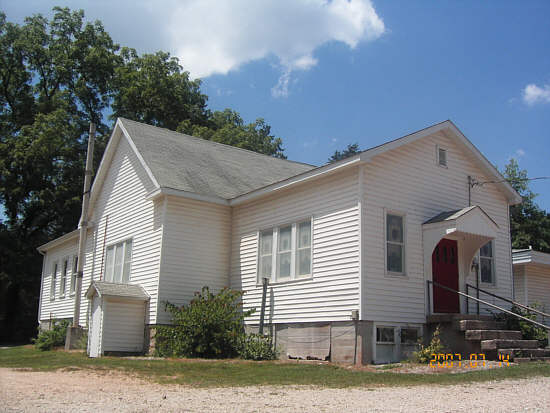 Bray's Advent Christian Church Bray's Advent Christian Church has expanded and remodeled its building. The basement was dug in 1947 with a slip and mules. Additions have been built on either side of the original one-room sanctuary.
BRUMLEY CHRISTIAN CHURCH
By Mable C. Hawkins
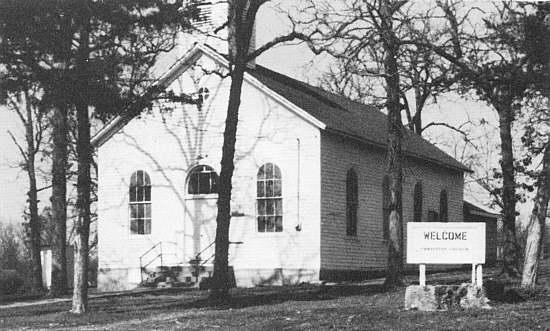 Brumley Christian Church On the 5th day of October, 1883, Elder D.W. Conner started a meeting in the Town Hall at Brumley, Mo. The meeting continued for six days during which eighteen persons made the confession of faith and were baptized. Six more transferred from other churches. This group decided to form a congregation at Brumley at the close of the meeting. They gave others opportunity to come into the organization. In all, forty-two became members of the Brumley Christian Church. Reverend Conner became the first pastor.
In April of 1888 Brother James C. Thompson was ordained into the ministry at the Brumley Christian Church. He became the pastor shortly thereafter and was pastor for sixteen consecutive years and also much of the time until his retirement. Reverend Thompson (often fondly known as "Preacher Jim") was married to Mary Eliza Bruin in 1877. They reared a large family on a farm northeast of Brumley. His daughter, Mrs. Cliffie Ford, lives in Eldon, Mo.
At the 50th Anniversary, October 1, 1933, both Rev. Conner and Rev. Thompson were present and took part in the program. Two charter members, J.M. Hawkins and Mrs. Betty Wright, were present.
Families prominent in the building and maintaining of the Church were Mr. and Mrs. H.C. Jackson, Dr. and Mrs. J.L. Conner, Mr. and Mrs. J.M. Hawkins and her mother, Mrs. Nancy Martin, Mr. and Mrs. W.R. Carnes, Mr. and Mrs. Maston Wornell, and Mrs. J.W. Lupardus, Mr. and Mrs. W.P. Hale, Mr. and Mrs. Perry Martin, Mr. and Mrs. Hiram Robinett, Mrs. B.F. Cook, C. F. Spearman and her husband Zebedee Spearman. Too numerous to mention are the descendants of these who later married and their families carried on the work of the Church. Other ministers who helped lead and preached there were W.H. Scott, Frank Moneymaker, Virgil Smith, Samuel Crouch, Jimmy Kruse, A.L. Alexander, Lee Todd and _____ Jeffries.
Church services were usually held only once or twice a month. However Sunday school was held every Sunday. Communion was observed each Sunday.
Superintendents of the Sunday school included J.M. Hawkins, Mrs. C.F. Spearman, Clyde S. Thompson, C.R. (Ted) Hawkins and James L. Thornsberry.
During the 1960's the Church withdrew from the "Christian Church Disciples of Christ" and is now an independent Christian church. In 1976 a large multipurpose room was built to accommodate the need of additional classrooms and other church activities.
The current pastor is Brother Ralph Byrd.
FAIRVIEW CHRISTIAN CHURCH
Reprinted from the 1975 Bicentennial edition of the Miller County Autogram-Sentinel
The Fairview Christian Church was organized by C.M. Sooter and the Rev. W.M. Sooter on Aug 12, 1911. Rev. Sooter was elected chairman, W. F. Hensley secretary and Sam Burks, treasurer. Deacons elected were J.W.P. Jarrett, G.W. Groves and J.D. Brumley. Stewards elected were C.C. Setser, Chris Reed and G.F. Jarrett.
Members elected to the building committee were J.M. Crane, Sam Burks, Andrew Jarrett, T.J. Hensley, David Bailey, G.M. Ramsey, John Shackleford and John Brumley. Members appointed to the standing committee were James Jarrett, Oscar Jarrett, Everett Crane, Mrs. Stella Setser, Mrs. Jane Groves and W.F. Hensley.
On August 15, 1911, a parcel of land consisting of one acre was deeded to the church by Sarah E. Fancher for the sum of $15. Trustees of the church in this transaction were S.I. Burks, J.D. Brumley and W.F. Hensley. The church building was started the first week in August 1911, the labor all being done by the people of the community. The first service was held in the building the first Sunday in September, 1911, just a month after the building was begun. The Rev. W.M. Sooter gave the first sermon.
FIRST CHRISTIAN CHURCH OF ELDON
Reprinted from the 1975 Bicentennial edition of the Miller County Autogram-Sentinel
 First Christian Church Eldon, Circa 1908 First Christian Church of Eldon was a branch of the Old Salem Church which was organized in 1852. The land for the church and cemetery was leased to the Christian Church for 99 years by Hiram Houston. This church was disbanded in 1882, the building sold for $312 and divided into three parts: W.T. Franklin, trustee for Mt. Pleasant--$104, J.J. Haynes, trustee for Eldon--$104 and J.T. Gilliland, trustee for Olean--$104.
The Eldon Congregation was organized in June 1884 with the Rev. David Conner serving as the first pastor. The congregation's first church building was erected in 1889, on the west side of Maple Street, near the Rock Island Depot. The site was donated by Silas Brickey. This building was sold and a dwelling made of it; the dwelling was later made into an apartment house. The men prominent in the building of this church were J.J. Hanes, J.B. Allen, W.B. Jones, A.C. Foote, C. Knoblock, C. Barkalow. The church was dedicated on September 1, 1889, by G.A. Hoffman of St. Louis. Rev. E.F. Hoffman was chosen as pastor and preached the first sermon in the new church the fourth Sunday in April 1889.
In January 1893, Rev. Edmund Wilkes of California, Missouri, began a meeting which was a great success. It lasted 33 days. There were 139 additions and much lasting good was accomplished for the community. Bro. Wilkes was chosen as pastor and served the church until 1895 or 1896. The present church was built in 1893 on lots donated by R.S. and Cirrelda Harvey in March, 1893. The committee superintending the building was J.J. Haynes, S.J. Etter, R.S. Harvey, J.S. Franklin, Dr. J.A. Stevens and Dr. H.H. Brockman. The church was completed in 1893 and was dedicated on the last Sunday in December. Brother Wilkes was assisted in dedicatory services by Bro. Sappington of California, Missouri, and Bro. J.H. Garrison of St. Louis.
The first elders were A.G. Foote and W.B. Jones. The first deacons were J.B. Allen and W.M. Holloway. The first Sunday school was organized in August 1889, and of the officers elected only one remains with us-Mrs. G.D. Walker. In 1975 there were 484 members, 336 active and 148 non-resident. C.F. Sanner was the minister at that time.
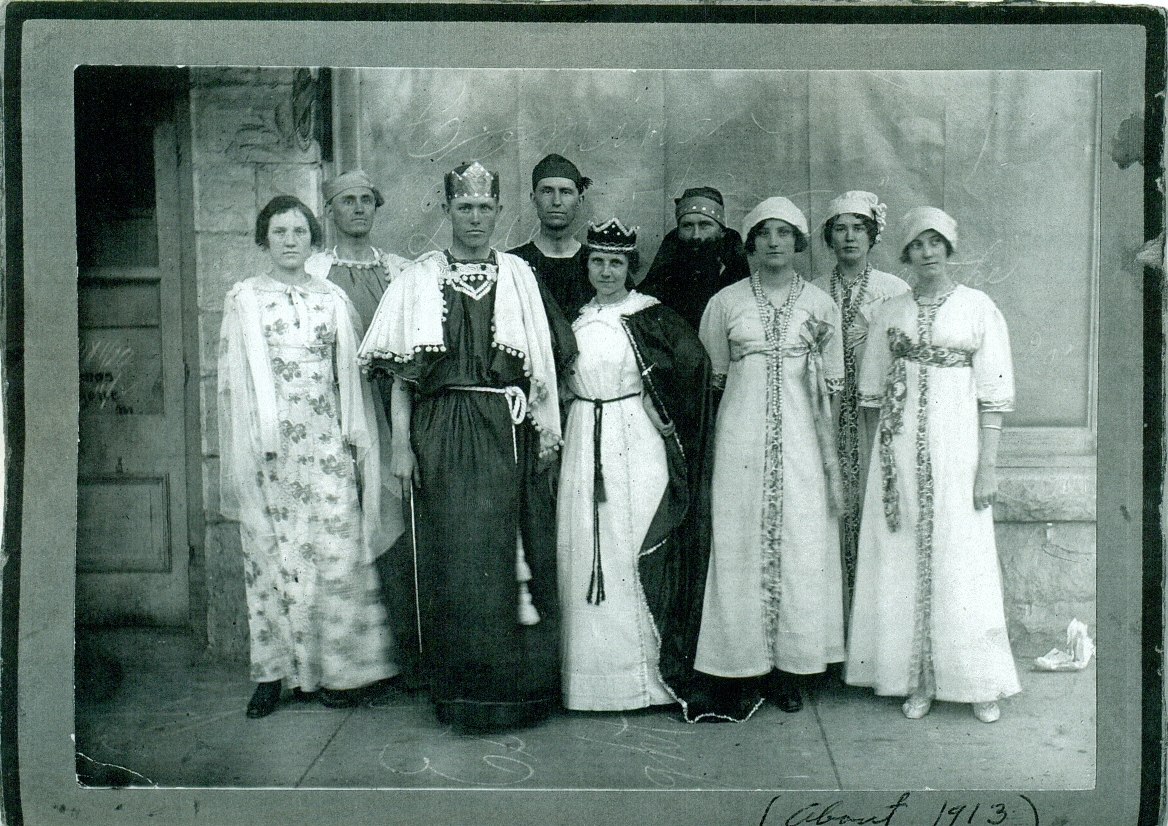 This is a group from the Eldon Christian Church taken about 1913
First row L-R: Nanny (Ritchie) Brazier (wife of Melvin), J.C. Roberts, Lillian (?? maiden name) Brazier (wife of Everett), Flora (Brazier) Roberts (wife of J.C.), Nora Brazier (sister of Flora).
one name in the back row--Melvin Brazier, far left.
HICKORY POINT CHRISTIAN CHURCH
By Joe Pryor
In the beginning my research about the Hickory Point Christian Church for the Miller County Historical Society was somewhat a mystery. First, the church building no longer exists; the only evidence of it is some pale crumbling limestone remains along the side of the road in a field a few miles off highway 17 in Miller County between Tuscumbia and Iberia. I would never have found it were it not for the help of Ruby Spearman, who used to attend the church as a child. Also, on maps which localize it by global satellite, it is located so close to Hickory Point Baptist Church, which is a thriving active church on KK off Highway 17, that early on I thought references to a Hickory Point Church were referring to the Baptist church. However, I knew a Hickory Point Christian Church had to have existed since my own family lore from my mother's side of the family, the Bears, indicated that Absolom Bear, my great great uncle, was one of the early supporters of the church. And I also knew that Absolom and many of his family were buried in the Hickory Point cemetery. Also, some vague short references to a Hickory Point Christian Church could be found in Goodspeed's as well as some other resources. For example, according to Goodspeed's History of Miller County:
"Hickory Point Church began its career in August, 1878, under the direction of Revs. N. Davis, E.W. Burks and A. Bear. Their membership of twenty three has since increased to eighty eight under the successive pastorates of Revs. N. Davis, J.H.D. Thomson, J.C. Martin, D.T. Connor, J.H. Aust and E. Wright. They still use their log building, erected in 1879, eleven miles south of Tuscumbia."
Also, a short paragraph in a history of Miller County Baptist churches published by the Miller County Baptist Association states that in the late 1800's the "Alexander Campbellite Movement came into the area and as a consequence a good number of people left the Hickory Point Baptist church and started the Hickory Point Christian Church. "
In the booklet, "Hickory Point Baptist Church: 150th Anniversary", compiled by Iris Burks, the following is quoted: "In this year (1854) the first mention is made of the Alexander Campbell Reformers coming in. This split the church wide open, and according to the records, about one third of the members' names are marked 'excluded' and those remaining are marked 'transferred,' which could mean they started all over."
According to Ruby (McCubbin) Spearman, who was born in 1930 and attended Hickory Point Christian church all her childhood life, the McCubbin family was one of the most important supporters of the church at that time. Upon review of the Hickory Point Baptist Church 150th anniversary booklet, a number of McCubbins who were some of the original members of the Hickory Point Baptist Church are no longer listed after about 1860. Also, the McComb name, which Mrs. Spearman reports was the name of one of the families which attended Hickory Point Christian Church, was no longer listed among those attending Hickory Point Baptist Church. Therefore, it is likely that many of the early members of the Hickory Point Baptist Church were instrumental in starting the Hickory Point Christian Church, which was located just a quarter mile north.
Mrs. Spearman's father, Clyde McCubbin, was one of the elders at Hickory Point Christian Church. She remembered the church being constructed of lime stone with a sign above the door saying it was built in 1897. I suspect this was not the first building used by the church since the Goodspeed reference quoted above records that the church actually was started in 1879 and was made of logs. Mrs. Spearman remembers that members of the Bear family were said to have been early supporters of the church having donated money and land. Absolom Bear was a name she heard mentioned often although she never remembers seeing him since he died in 1932 ( her farm, including the house built in 1918 in which she now lives, originally belonged to Frank Bear, a son of Absolom). . The preachers she remembers as a little girl were Frank Moneymaker, and a "Preacher Wood" (Orlando Wood) who came there in 1929 from Indiana. Mr. Wood also preached at Pension Ridge church and "stayed with a Mr. Rodden". . She remembers that Preacher Wood was of Church of Christ background which did not believe instruments were appropriate for the worship service. He and Nancy Bear, daughter of Absolom, were fond of each other and were to be married; however Nancy died suddenly of pneumonia. Mrs. Pearson was told by her father that Nancy only would let women take care of her and that she would not see a male doctor.
According to Camilla (Patterson) Dake, another preacher who preached at Hickory Point Christian Church and who was of the non instrumental persuasion was John Davenport, her grandfather on her mother's side. The family of Mrs. Dake's husband, Everett, was regular in attending the church. She reports that Mr. Davenport rode a horse and buggy to Sunday services from his home in Ulman, Missouri, three miles to the north. He often would travel further south to preach in the yard of Mrs. Dake's Patterson relatives and family since they lived too far away to attend services at Hickory Point very often.
Another famous Miller County Church of Christ minister who preached at Hickory Point Christian Church was J.H.D. Thomson.
Apparently, the Hickory Point Christian church at times was non-instrumental and other times used a pedal organ. The pedal organ, according to Mrs. Spearman, originally had been given to the church by the Bear family in the late 1800's when the church was started, but in later times was not used.
Some of the family names remembered by Mrs. Pearson of people who attended the church were Bear, Dake, Williams, McCubbins, Slone, McComb and Case.
In 1965 severe wind damaged the church and blew off part of the roof and wall. Thieves began breaking in and stealing articles. The members of the church removed benches and other more valuable articles and dispersed them among other members to prevent them from being stolen. Because the church attendance had been falling a decision was made not to rebuild the church. Mrs. Spearman had the opportunity much later to purchase at a sale the old organ which originally was donated by the Bear family. The old organ had not worked well for many years and wasn't used when Mrs. Spearman attended church there as a child. She remembers that her father, Clyde McCubbin, who was an excellent musician, repaired the organ. He was perplexed, she relates, that the wooden percussion hammers and rods and other elements of the inside workings of the organ were covered by a sticky substance and that the splinters cut away from the wood "tasted sweet".
Mrs. Dake recalls that she and her husband were fortunate to have the opportunity to purchase an old candle chandelier which once belonged to the church and which now hangs from the ceiling in their living room. She recalls that some of those who attended Hickory Point Christian Church later attended Mt. View Church of Christ which was located at the highway 17 KK junction.
After the church closed, members dispersed and went to other surrounding churches, especially Mt. View Church of Christ and Pleasant Hill Christian Church which is the one Mrs. Spearman now attends.
Thanks are given to Mrs. Ruby Spearman, Mr. and Mrs. Everett Dake, Sue Wall, and Katherine Ponder. Other sources included Goodspeed's History of Miller County, Miller County Baptist Association, and Hickory Point Baptist Church: 150th Anniversary.
THE CHRISTIAN NEW LIGHT CHURCH
By Peggy Smith Hake
The Christian Newlight Church was organized in the 1890's and their first meetings were held in the G.A.R. (Grand Army of the Republic) Hall which is still standing on the original site today. Some early pastors of this church were C.M. and Ned Sooter and John Aust, the father of Uncle Charley Aust and Aunt Sally Jones whom I remember so well as I was growing up in the Iberia area.
About the year 1899, the members of the Newlight Church decided to build a place of worship and they acquired a small tract of land on the north side of Iberia and there they built their small church where it still stands today.
Reverend C.M. Sooter was the minister of the Christian Church known as the "New Lights". He was born in Newton County, Missouri, August 24, 1857. When he was 27 he began to preach. Although he was a man without education, he became one of the most effective preachers of his day. He has baptized converts in the Osage River, Big Tavern, Sugar, Cat-tail, Dog, Coon, Brushy, Barren, and Humphrey's creeks. The greatest number ever baptized by him at one time was 72 immersed and four sprinkled. He has organized the following churches in the county: Union, Atwell, Iberia, Fairview, Gott's Graveyard, Mt. Zion, Humphrey's Creek, and Mount Gilead.
The 'New Light' Church was an off-shoot of the old Disciples of Christ/Campbellite Christian churches. None of these churches are existence today and most of the members would be attending a Christian Church (Disciples of Christ). Fairview Christian Church in rural Iberia was established by Rev. Sooter and some of his descendants are still there and very involved in the church's functions.
SALEM CHURCH IN SALINE TOWNSHIP, MILLER COUNTY, MO
by Peggy Smith Hake
The Disciples of Christ, first known as Campbellites, organized a church in Miller County in 1841 in Saline Township. This was not the first church this denomination had organized in the county because in 1835, Elder Isaac Clark formed what was probably the first Christian church in the Big Richwoods of southern Miller County. A second Christian church was organized at Spring Garden in 1840, which became known as the 'Mother Church' of the Disciples of Christ.
The church which organized in Saline Township in 1841 was first called Mt. Vernon; the name taken from the Baptists who had already established a church in Saline Township in 1840. They called their church Mt. Vernon tabernacle. The land was donated to the Baptist group by Ebenezer Vernon, thus the name "Mt. Vernon" was given to the old church. When differences arose between the Baptists and Disciples of Christ (in the autumn of 1851), the Disciples moved away and established the Salem Church about one-half mile west of the old Mt. Vernon Church. It had taken 10 years for them to have a "parting of the ways". They had shared the same building for those 10 years.
In 1852, the church fathers appointed Albert G. Wilkes as a trustee to lease 20 acres of land from Alfred M. Houston to build a new meeting house. This transaction can be found at the courthouse in Warranty Deed Book B, page 267. After the new church was built in 1852, it was then known as Salem. Its early pastors included Rev. William Jones and Rev. Nelson A. Davis. In later years, some of the traveling preachers who served the congregation were Rev. Findlay, J. H.D. Thomason, J. S. Bonham, and John Bezoni.
On October 12, 1884, Mt. Pleasant Christian Church grew from Old Salem Church and a new church was built 3 miles east of Salem. When the new church was built, the area families who became active members of Mt. Pleasant were the Franklins, Gartins, Etters, Walkers, Crisps, Adcocks, Dunhams, and others to the number of 64 persons. By 1889, the membership had reached 135 and their frame church was valued over $1,000. The chronological and historical order of the church was as follows:
From 1841-1852------it was known as Mt. Vernon Church
From 1852-1884------it was known as Salem Church
From 1884-present---it was known as Mt. Pleasant
In old Salem cemetery are 256 known grave sites which were inventoried in June, 1968 by Gwen Shoemaker of Eldon. As far as can be determined, the oldest burials are: JOHN BROCKMAN, son of Wm. M. and Cirelda Brockman (1851-1851-died at age 11 days); and SAMUEL DRESSER, pioneer of Massachuetts (1785-1851).
There are at least two Civil War soldier buried there including ALEXANDER G. SCONCE, Co. B 13th MO Cavalry 1839-1922 and FRANCIS M. SCONCE, Co. B 13th MO Cavalry (no dates). I would venture a guess they were brothers.
Some of Miller County's oldest pioneers are buried in this very old burial ground. Men who served in the Civil War and World War I are laid to rest there and if a thorough research was made, you might find that some of the other men could have been veterans of the War of 1812, the Indian Wars, the Mexican War, and perhaps the Mormon War of 1838. When you review all these fascinating facts about Old Salem cemetery and church, you realize that it is pure, complete, and unquestionable history!
NOTE: Salem Cemetery was established next to the new building, which the Disciples of Christ built in 1852 (about one-half mile west of Mt. Vernon Church).
MT. PLEASANT CHRISTIAN CHURCH
By Mary Jones
The Mt. Pleasant Christian Church was built in 1884. Mt. Pleasant, the first village in Miller County, was at that time known as Pleasant Mount.
Earlier the community had Baptist missionaries, Methodists, circuit riders, and reforming Campbellites. In 1851 the Disciples of Christ separated from the church at Mt. Pleasant and built the Salem Christian Church about three miles westward.
On Oct. 12, 1884, the Rev. W.G. Findley who had been preaching at the Salem Church, established the Mt. Pleasant Christian Church, the Missouri Pacific Railroad having separated the Mt. Pleasant community from Salem.
Among the ones who came from Salem were the Franklins, Gartins, Hayneses, Millers, Atkinsons, Brockmans, Dooleys, Etters, Walkers, Crisps, Adcocks, Stoddards, Gillelands, and others to the number of 64.
The land for the church was donated by James Etter. At the time the church was built it was decided to build a frame structure valued at $1,000. One of the helpers was Jimmie Hix.
The first revival meeting was held by Rev. Sallee at which time several more united with the church. By 1890 there were 135 members.
The church building was dedicated Feb. 29, 1888, three years and four months after its completion. Services were conducted by the Rev. G. A. Hoffman. He preached one sermon at the church on Feb. 28, 1888, and three sermons on Feb. 29 and raised $57 at the dedication service. He also dedicated the church at Tuscumbia and the frame church at Eldon.
Among the early preachers were the Revs. W.G. Findley, J.H.D. Thompson, S.D. Dutcher, Sallee, G.A. Hoffman, J.S. Bonham, John Bezoni, H. Drennan, W.H. Scott, S.A. Crouch, and A.L. Alexander.
The first officers of the church were: Elders, J.M.T. Miller and J.M. Brockman; deacons, M.S. Dooley and R.H. Franklin. When the church celebrated its 50th year, the elders were G.H. Miller, Fred Etter, and J.J. Wyrick. Deacons were Alva Goodrick and Buck Graham.
MT. ZION CHRISTIAN CHURCH
By Joe Pryor
Information obtained from "History of Miller County" by Clyde Lee Jenkins, church historical records, Rayma Flaugher, Reba (Sooter)Martin/ Graham, Susie (Bear) Pryor, Carl Schlesinger, Gladys Musick and Gene Edwards.
Mt. Zion Christian Church is what is now called a New Testament Christian Church. It is one of the churches of the original "restoration movement" which came out of the early part of the 19th century in which Thomas and Alexander Campbell as well as Barton Stone were some of the principal leaders. One movement within the Campbell/Stone group was known as "New Lights" which according to Clyde Lee Jenkins "History of Miller County" was promoted by James O'Kelly of Kentucky. In our local area, Reverend Charles Sooter was a strong advocate of the "New Lights" having started a number of churches in Miller County including Mt. Zion Church which first opened its doors on January 12, 1889. Reverend Sooter preached for many years at Mt. Zion Church (as well as the other churches he started) before he passed away in 1938. He was influenced early in his life by a "New Light" preacher from Iowa, "Preacher Mapes". Interestingly, in all the 118 years that the church has existed, only four ministers of the gospel have led the congregation. After Reverend Charles Sooter passed away Reverend Mark Sooter, the son of Reverend Charles, was called to perform preaching responsibilities and he preached until 1975. Following him Brother Gene Edwards preached until the early 1980's. Brother Charles Worstell joined the congregation as minister in 1980 and remains the church minister up to the present date.
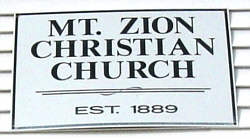 |
The first building, erected in 1889 was destroyed by fire on January 1, 1913. The present building was rebuilt and dedicated on June 10, 1917. Many additions have been constructed to the building over the years including classrooms, a fellowship area and other modern conveniences including padded pews and air conditioning. Brother Gene Edwards donated the bell that the church has which came out of the old Howell School near Ulman, Missouri. The fellowship hall was the newest addition having been completed in 2003. Many volunteers have donated a large number of hours of labor motivated by their love to serve in order to accomplish what otherwise would have required a great deal more funds to complete. According to Reba (Sooter) Martin/Graham, whose grandfather was Charles Sooter, the church has been blessed by the financial support for its projects by members from the past who no longer live here but have fond memories of worshipping at Mt. Zion in their past.
Well known family names from south of the Osage River are associated with Mt. Zion Christian Church including Abbott, Abbett , Adcock, Ahart, Bear, Brumley, Clark, Clement, Crane, Curry, Edwards, Flaugher, Glawson, Graves, Helton, King, Lovell, Lupardus, Martin, McDonald, Musick, Nixdorf, Roberts, Robinett, Schlesinger, Thompson, Whittle, Wyrick and many others. These names are recorded on the many tombstones in the cemeteries located at Mt. Zion. The old cemetery on the west side of the church contains grave stones with birth dates originating well before the civil war including that of William Wyrick who was born in 1842.
My mother, Susie (Bear) Pryor has fond memories of attending the church services at Mt. Zion as a child. Her cousin, Reba Graham (quoted above), was the source of some of the information in this short history of the church. Quoted below are some recollections my mother gave me recently of what she remembered about worshipping at Mt. Zion:
Mount Zion Christian Church memories
Susie (Bear/Abbett) Pryor
Mt. Zion is the church that Grandpa and Grandma Bear (David C. and Mary Samantha) always attended; their farm was a few miles away on Coon Creek. The church really has had in the past a closeness to all our family. Many people who were friends of my family went there and even though we moved to town from the farm when I was pretty young we knew a lot of people from out around that part of the country. It is the church that David, my brother, and I joined at a very young age. We were baptized over in one of the creeks nearby to the west which runs along the valley up to the North. I sure remember lots of old-time happenings, especially the Basket Dinners we had out in the church yard. The men would carry the benches out of the church house and turn them over so the women could set the food on them. A lot of the people would clamor to eat what Mom brought because, since we had the general store in Tuscumbia, she would bring lunch meats and salmon and cheese, things that people didn't get to eat much of in those days. Of course, I would rather eat the food that everyone else brought from the farms where they all lived. It was really good old home cooking.
I remember the church had what was then called an "Amen corner;" the men would sit together near the front to emphasize with "amen's" something the preacher said which they thought was very important; that always intrigued me. Uncle Charlie Sooter's sons would sing and play their guitars, mandolins and fiddles. Uncle Charlie could play the fiddle really well. There were always about 5 or 6 of the adults who stood up behind the old fashioned organ and it seemed to me they were trying to see who could sing the loudest…..and I thought my Aunt Ella (Abbett) Sooter usually was the loudest. Jennie Bear was the one who played the old pump organ at the time. I well remember the big black iron stove near the front of the church which helped keep us warm during the worship service in the wintertime. We always sang the old songs and the music tablature was what was called "shape" notes. However, I think Aunt Jennie probably didn't need music notes to play. She was the mother of Lydia (Bear) Nixdorf and lived with Lydia and her husband Vic Nixdorf.
Mom would always take some kind of crackers or cookies to pacify the little ones. All the people from over in that area came to my folks' store in Tuscumbia and traded. Mom never failed to see that a few pieces of candy "accidentally" found their way into the grocery bags before the folks left the store. After church sometimes I would go to the homes of my friends as also would mom and dad. Once in awhile I would stay overnight with my cousin Edith at Uncle Vic and Aunt Lydia Nixdorf's farm. My memories of Mt. Zion Christian Church are some of the happiest of my life.
A BRIEF HISTORY OF PLEASANT HILL CHURCH
(Richwood Township, near Iberia, MO)
by Peggy Smith Hake
There have been two churches called Pleasant Hill. Before his death in the early 1980s, I spoke at length with Hite Boren of Hawkeye. He had reached the age of 101 years and when I spoke with him, his memories were wonderfully vivid. He told me about the two different churches called Pleasant Hill.
The first church was built about one and half miles southeast of the present location. It was a small, log structure and was near what was later called 'the Johnny Shelton place'. He also believed there were at least 3 graves located near the old church.
The first Pleasant Hill church was also called Peakey Church. Of course, there was a reason for that name! Some of the mischievous, young boys would crawl under the puncheon floors during church services and would 'peak' between the logs. They got an eye-full of the pointed end of the ladies umbrellas!
When the second Pleasant Hill church was built in the 1880s at the present location, the folks of the community called them Pleasant Hill Church No. 1 and No. 2....some continued to call the churches Peakey Church No. 1 and No. 2.
Today's church, constructed of cement blocks, is the third to sit on the present site. The first was built of logs and sat in the southwest corner of the cemetery. The second, a one-room frame building, was built where the present church sits. I remember the old frame church so well because it was in use when I was a child in the 1930s and 40s.
The oldest grave in Pleasant Hill cemetery is a Civil War veteran, William Long, who served in Company E of the 52nd Kentucky Infantry. His burial place is in the southwest corner of the cemetery. He was buried there in the late 1880s. Prior to the beginning of Pleasant Hill Cemetery, many ancestors were buried at the old Rankin Wright/Spearman cemetery, situated a few miles northeast of Pleasant Hill.
Members of the following families, familiar to the area, are buried at Pleasant Hill: ALEXANDER, ALLEN, ANDREWS, BOREN, DRACE, DUNCAN, GREENWOOD, JOHNSON, KEETH, LAW, LAWSON, LONG, MADDEN, MEREDITH, MONEYMAKER, PEMBERTON, ROWDEN, SHELTON, SLOAN, STITES, STONE, STRUTTON, TABOR, TEAVERBAUGH, THOMAS, THOMPSON, VAUGHAN, WALL, WALLACE, SHITTLE, WOOLERY, WRIGHT, and WYRICK.....Less familiar names to the community buried at Pleasant Hill include: ABBOTT, BROWN, DESUZA, EAKEN, HATTON, LANKFORD, MANES, NEAL, PARKHURST, REGGAN, SHART, and STURDAVANT.
And, as in many cemeteries, there are several fieldstones marking gravesites. Many of the persons buried in such places are known only to God.
In the mid 1880s, there was a fight, which broke out on the outside of the old church house (I imagine it was the original log structure). John Whittle was killed in the fight and his brother, Robert Whittle, was wounded. In the history book, GOODSPEED'S HISTORY OF COLE, MONITEAU, MORGAN, BENTON, MILLER, MARIES, & OSAGE COUNTIES @1889, there is the following paragraph describing the fight at Pleasant Hill.........
"The State of Missouri vs. C. R. Adams, in 1886, was another Iberia Killing affray in which John Whittle was killed and another wound. The Adams and Whittle families had been rather feudal for years, and it extended to the boys, who, on one occasion, were at Pleasant Hill church. Charles R. Adams, then about 19 years old, was accused by John Whittle of ridiculing a certain little girl. Adams denied it, and finally Robert Whittle made a rush at Adams, who shot both. Attorneys Wyrick, Musser, Moore, and Williams secured a verdict of $500 fine, but through the influence of the defense, Attorneys Robinson and Pope and others, the governor remitted the fine."
The full transcript of the trial, which was held at the courthouse in Tuscumbia, can be found in the office of the Miller County Circuit Clerk.
NOTE: Pleasant Hill Church is located in Richwoods Township, Miller County, MO, a few miles southwest of Iberia. It sits about a mile east of State Highway EE on County Rd. EE-10.
It first had members that were Church of Christ believers and also Disciples of Christ.....there was an argument that occurred many years ago about a piano being used in the church during services and some of the members left (the Church of Christ folks) and the others remained. It is considered a part of the Christian Church movement today. My mother attended this church as a child and she told me this old story many times!
-PSH
TUSCUMBIA CHRISTIAN CHURCH
By Joe Pryor
On top of the hill in Tuscumbia, which overlooks the Osage River and the valley below, is the street which at one time was one of the busiest in Tuscumbia because it led to the Miller County Courthouse. On this street were located the houses of many of Tuscumbia's most important early families including those of C.B. Wright, Charles Snodgrass, Byron Hix, Frank Thompson, and T.C. Wright, Dorsey Barron, Leonard Kallenbach, Garrett Berry, and Jackson Stanton. In the middle of the street facing southwest is the building which has been the home since 1889 of the Tuscumbia Christian Church. Many of Tuscumbia's most important early families attended services here.
Because of disturbances which occurred during the Civil War, church activities had not been housed in a regular building for probably two decades before the present building was constructed. It is the second church to have ever been built within the town. For several years beginning in 1878 services had been held in the school and courthouse.
Reverend W.P. Dorsey was the first minister and was the one who initiated the organization of the church in January of that year. It was said of Reverend Dorsey at the time that he was a "young man of some talent and which, if properly cultivated, he will someday become an able minister of the Gospel." The church had the distinction of being the first in Miller County to have started a Sunday school.
On August 4, 1889, the present building, built by Squire John Hickman, was dedicated by Elder G. A. Hoffman at a service attended by citizens who arrived from all parts of the county. The Tuscumbia Autogram reported that "People began coming in from every direction early in the morning, and long before time for services to begin the house was packed to its utmost capacity, while the people at the windows on the outside of the house were a considerable number."
One of the most interesting features of the new building at the time was the church bell which arrived in Tuscumbia in mid July, 1889, by travel upstream on the Osage River carried by the steamboat Frederick. The Frederick was named after the son of William H. Hauenstein Jr., who was one of the early businessmen in Tuscumbia. The excitement of bringing the bell upstream on the steamer was great and it was said that boys on the boat commenced ringing it at a point six miles downstream from the landing at Tuscumbia and the pealing was "heard by nearly everyone in town". The bell was heavy weighing 529 pounds and after being positioned in the church belfry could be "heard eight to ten miles" away. About seventy five years ago, after the church had been built, the leadership decided to build a basement. All the young men worked together to dig out by hand a basement removing the dirt by wheelbarrow. A concrete floor was then laid one square at a time requiring very intensive labor due to the confinement of the walls of the previous construction.
Early members of the church included many prominent Miller County citizens with surnames which persist to this day throughout the area in their descendents. Long time residents of the county will recognize many of these surnames including Birdsong, Wright, Thompson, Robinson, Waddell, Hawken, Jukes, Swanson, Lawson, Kallenbach, Richardson, McGee, Goodrich, Mellon, Williams, Cotton, and many others. Numbered among the first elders and deacons were T.B. Robinson, John Kallenbach, G. W. Birdsong, J.P. Wright and Judge J.H.Todd.
Through the years the church has been pastored by many ministers including Elders E.B. Woods, W.H. Scott, S.A. Crouch; and Reverends Irwin Sons, W.E. Waddell, John Jenkins, A. L. Alexander, and Gene Edwards. In recent years, the church has experienced exceptional growth under the leadership of Reverend Larry Schraer.
Successful revivals have been part of the church's history from the very beginning. But the most successful revival occurred in June of 1971 conducted by Reverend Harold T. Mayes when 25 people of various ages were baptized at Riverside Park in the Osage River. It has been said by some of those who were there that this event was one of the most joyous and spiritual experiences of their memories of attending the church.
Two notable celebrations of the church were the Fiftieth Anniversary in 1939 and the One Hundredth Anniversary in 1989. When I reviewed the program of the Fiftieth Anniversary childhood memories were awakened as I remembered some of the program participants including Mrs. L.E. Kallenbach, T. C. Wright, G. A. Berry, H.C. Wright, L.A. Wright, and Juanita Messersmith; all of whom I remember as being very well respected and honored members of our community in Tuscumbia. The hymns selected for the program were ones all of us my age loved and miss so much hearing these days. At the celebration ceremony note was made of the parsonage which the church acquired across the street in 1977.
The One Hundredth Anniversary celebration similarly was memorable, especially the keynote address by Dorill Wright. Dorill, one of our Tuscumbia Timothy's who became a community leader in the faraway city of Port Heuneme, California, presented a somewhat autobiographical account of his childhood memories of the church which was moving and reverent.
Currently, the church is undergoing an expansion of building facilities made necessary by the significant increase in membership under the leadership of Reverend Schraer. Especially impressive at the moment is the youth program which has attracted many new young people to the Sunday services and other events throughout the week.
Information obtained from Bamber Wright, Genevieve Sullivan, programs of the Fiftieth and One Hundredth Year celebrations, keynote address by Dorill Wright (October 15, 1989), Judge Jenkins' History of Miller County, Gerard Schultz's History of Miller County, and personal memories.
ULMAN CHRISTIAN CHURCH
By Myna McGowin
Simeon Bear, a pioneer resident of Ulman, willed one acre of ground and one thousand six hundred dollars to be used in the building of a Christian Church building in Ulman. He appointed A.C. Jackson, James C. Thompson and George Bear as administrators of this building fund and land to see that his will be carried out.
The church building was erected in 1921. The contractors moved their machinery to the site of the building and made the blocks of which the building was made.
Some of the charter members were: Mrs. A.P. Nixdorf, Mrs. R. Crismon, Mrs. Grace Hix, Mr. and Mrs. Rig Patterson. After the building was completed James C. Thompson appointed Rufus Crismon, A.P. Nixdorf and C.B. Bass as trustees.
A Bro. Brown held the first revival meeting and dedication during which time a great number members were added. Br. W.H. Scott became the first pastor of the church and Mrs. C.B. Bass was the first Sunday school superintendent. Mrs. Lora Abbett was the first pianist.
The building still stands as it was erected in 1921 with the addition of a belfry in 1930. A new pine floor has been placed over the original concrete floor and the interior redecorated.
In 1970 an addition was placed on the back of the original building which houses classrooms and a basement.
OLEAN CHRISTIAN CHURCH
|
|


